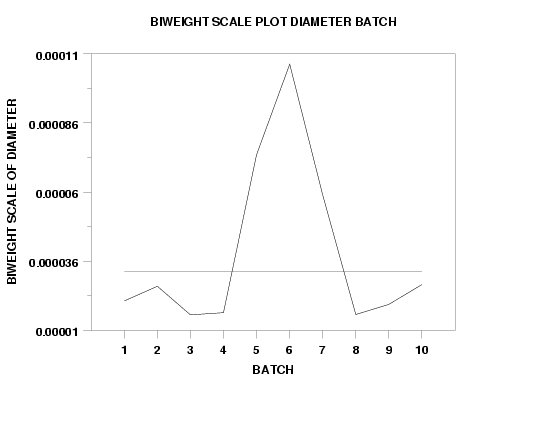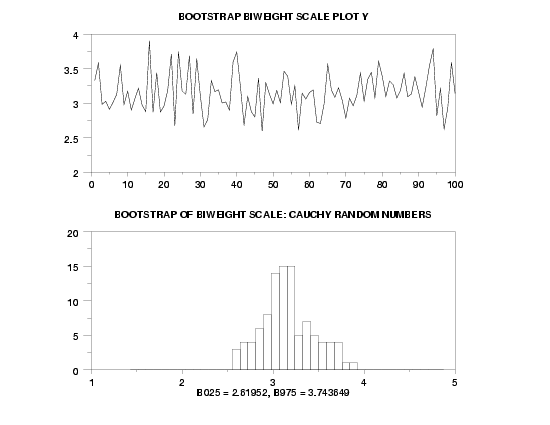

|
BIWEIGHT SCALEName:
Many statistics have one of these properties. However, it can be difficult to find statistics that are both resistant and have robustness of efficiency. For scale estimaors, the standard deviation (or variance) is the optimal estimator for Gaussian data. However, it is not resistant and it does not have robustness of efficiency. The median absolute deviation (MAD) is a resistant estimate, but it has only modest robustness of efficiency. The biweight scale estimator is both resistant and robust of efficiency. Mosteller and Tukey recommend using the MAD or interquartile range for exploratory work where moderate efficiency in a variety of situations is adequate. The biweight scale estimator can be considered for situations where high performance is needed. The biweight scale estimate is defined as:
where the summation is restricted to \( u_{i}^2 \le 1 \) and
and
where MAD is the median absolute deviation.
<SUBSET/EXCEPT/FOR qualification> where <y> is the response variable; <par> is a parameter where the computed biweight location is stored; and where the <SUBSET/EXCEPT/FOR qualification> is optional.
LET A = BIWEIGHT SCALE Y1 SUBSET TAG > 2
LET Y1 = NORMAL RANDOM NUMBERS FOR I = 1 1 10000
LET Y2 = LOGISTIC RANDOM NUMBERS FOR I = 1 1 10000
LET Y3 = CAUCHY RANDOM NUMBERS FOR I = 1 1 10000
LET Y4 = DOUBLE EXPONENTIAL RANDOM NUMBERS FOR I = 1 1 10000
LET A1 = BIWEIGHT SCALE Y1
LET A2 = BIWEIGHT SCALE Y2
LET A3 = BIWEIGHT SCALE Y3
LET A4 = BIWEIGHT SCALE Y4
LET B1 = STANDARD DEVIATION Y1
LET B2 = STANDARD DEVIATION Y2
LET B3 = STANDARD DEVIATION Y3
LET B4 = STANDARD DEVIATION Y4
LET C1 = MAD Y1
LET C2 = MAD Y2
LET C3 = MAD Y3
LET C4 = MAD Y4
PRINT "BIWEIGHT SCALE ESTIMATE FOR NORMAL RANDOM NUMBERS = ^A1"
PRINT "STANDARD DEVIATION ESTIMATE FOR NORMAL RANDOM NUMBERS = ^B1"
PRINT "MAD ESTIMATE FOR NORMAL RANDOM NUMBERS = ^C1"
PRINT " "
PRINT "BIWEIGHT SCALE ESTIMATE FOR LOGISTIC RANDOM NUMBERS = ^A2"
PRINT "STANDARD DEVIATION ESTIMATE FOR LOGISTIC RANDOM NUMBERS = ^B2"
PRINT "MAD ESTIMATE FOR LOGISTIC RANDOM NUMBERS = ^C2"
PRINT " "
PRINT "BIWEIGHT SCALE ESTIMATE FOR CAUCHY RANDOM NUMBERS = ^A3"
PRINT "STANDARD DEVIATION ESTIMATE FOR CAUCHY RANDOM NUMBERS = ^B3"
PRINT "MAD ESTIMATE FOR CAUCHY RANDOM NUMBERS = ^C3"
PRINT " "
PRINT "BIWEIGHT SCALE ESTIMATE FOR DOUBLE EXPO RANDOM NUMBERS = ^A4"
PRINT "STANDARD DEVIATION ESTIMATE FOR DOUBLE EXPO RANDOM NUMBERS = ^B4"
PRINT "MAD ESTIMATE FOR DOUBLE EXPO RANDOM NUMBERS = ^C4"
Dataplot generates the following output:
BIWEIGHT SCALE ESTIMATE FOR NORMAL RANDOM NUMBERS = 1.016386
STANDARD DEVIATION ESTIMATE FOR NORMAL RANDOM NUMBERS = 0.9975
MAD ESTIMATE FOR NORMAL RANDOM NUMBERS = 0.681249
BIWEIGHT SCALE ESTIMATE FOR LOGISTIC RANDOM NUMBERS = 3.066369
STANDARD DEVIATION ESTIMATE FOR LOGISTIC RANDOM NUMBERS = 1.817945
MAD ESTIMATE FOR LOGISTIC RANDOM NUMBERS = 1.116496
BIWEIGHT SCALE ESTIMATE FOR CAUCHY RANDOM NUMBERS = 3.480419
STANDARD DEVIATION ESTIMATE FOR CAUCHY RANDOM NUMBERS = 998.389
MAD ESTIMATE FOR CAUCHY RANDOM NUMBERS = 1.015878
BIWEIGHT SCALE ESTIMATE FOR DOUBLE EXPO RANDOM NUMBERS = 1.529625
STANDARD DEVIATION ESTIMATE FOR DOUBLE EXPO RANDOM NUMBERS = 1.424258
MAD ESTIMATE FOR DOUBLE EXPO RANDOM NUMBERS = 0.684497
Program 2:
SKIP 25
READ GEAR.DAT DIAMETER BATCH
TITLE AUTOMATIC
XLIMITS 1 10
MAJOR XTIC MARK NUMBER 10
MINOR XTIC MARK NUMBER 0
XTIC OFFSET 1 1
X1LABEL BATCH
Y1LABEL BIWEIGHT SCALE OF DIAMETER
BIWEIGHT SCALE PLOT DIAMETER BATCH

Program 3:
MULTIPLOT 2 1
MULTIPLOT CORNER COORDINATES 0 0 100 100
LET Y = CAUCHY RANDOM NUMBERS FOR I = 1 1 1000
TITLE AUTOMATIC
BOOTSTRAP BIWEIGHT SCALE PLOT Y
X1LABEL B025 = ^B025, B975 = ^B975
TITLE BOOTSTRAP OF BIWEIGHT SCALE: CAUCHY RANDOM NUMBERS
HISTOGRAM YPLOT
END OF MULTIPLOT

|
Privacy
Policy/Security Notice
NIST is an agency of the U.S.
Commerce Department.
Date created: 11/20/2001 | ||||||||||||||||||||||||